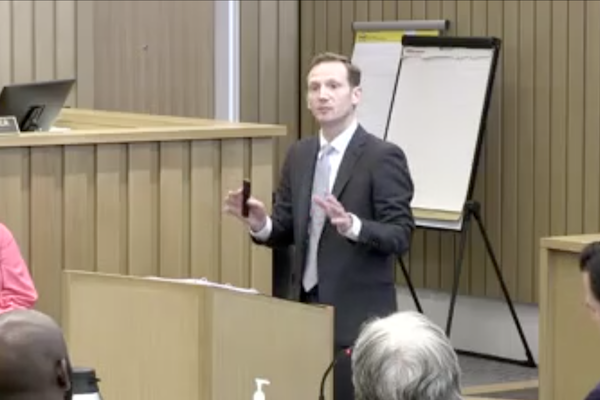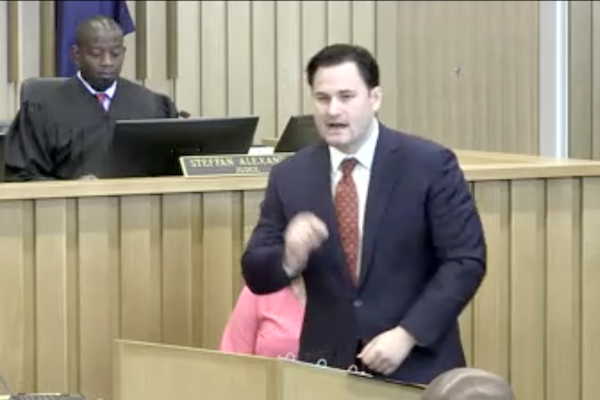Plaintiffs presented damning new evidence during opening arguments April 25, in a $2.2 billion civil trial against PacifiCorp by survivors of the 2020 Oregon wildfires.
Plaintiff attorney Nicholas Rosinia said PacifiCorp was warned by state regulators roughly a month before the fires about hundreds of trees in contact with power lines throughout the state.
Rather than try to mitigate the threat, said Rosinia, internal emails showed the company was worried about public backlash if the media found out.
“They knew they had a problem,” said Rosinia. “They knew, and they did nothing to prevent a fire.”
The trial began April 24 with jury selection in Multnomah County Circuit Court, with proceedings scheduled to last through June 16. Plaintiffs include roughly 5,000 survivors of the Santiam, Obenchain, 242 and Echo Mountain Complex fires, which sparked Sept. 7, 2020, during extreme wildfire conditions.
Rosinia told the jury PacifiCorp was notified in 2020 by the Oregon Public Utility Commission that an audit revealed 373 instances of vegetation in direct contact with energized equipment. This came after a similar notification in 2019 that 504 such instances were found, which regulators called “disturbing.”
An email between members of PacifiCorp’s internal communications team regarding the 2020 report said, “If this were to become a media story, we would need a very strong response.” PacifiCorp Vice President David Lucas said in a separate email: “I see a lot of liability from fires and third party injury claims in the event something happens.”
Rosinia said this was clear evidence PacifiCorp knew they faced a significant problem and deliberately took no action to mitigate wildfire risks.
He also noted PacifiCorp made the decision to keep its power lines energized as wildfire conditions intensified, though Portland General Electric and Consumers Power de-energized their lines. He said PacifiCorp even sent teams to the disaster areas to restore power as fires raged and high winds continued blowing trees into power lines.
“Pacificorp couldn’t be troubled enough to take any action at all to avoid starting the fires,” said Rosinia.

PacifiCorp attorney Doug Dixon said plaintiffs’ arguments oversimplified a complex case. He said new environmental conditions from climate change, as well as federal and state forest management policy, must be taken into account when determining how the fires actually started.
“Plaintiffs want to ignore a changing world and blame it all on my client,” said Dixon, who referred to the company by its Oregon business name Pacific Power. “Why? Because they view Pacific Power as an easy, as a convenient target, and you can’t sue climate change.”
Dixon said PacifiCorp was a “pioneer” in adapting to climate change, including in 2019 when it developed a wildfire mitigation plan for high-risk areas within its Oregon services territories. It also developed a public safety power shutoff plan among other progressive policies, said Dixon.
“The list could go on, but the truth is no one can ever predict precisely where a fire is going to start, and that was especially true on Labor Day, 2020,” he said. “…The law does not require for Pacific Power to have a crystal ball.”
Dixon said his client chose not to de-energize power lines in 2020 after weighing wildfire risks against the potential harm to utility customers if they lost power. He said de-energization for public safety was “extraordinarily rare” and “highly controversial,” and a natural disaster is when customers “need power the most.”
He said stories from plaintiffs who lost everything in the fires were “absolutely heart wrenching,” and everyone “feels awful for the harm that they have experienced.” He said the main question of the lawsuit was a different matter of whether or not PacifiCorp’s equipment ignited the fires, and if the company had taken reasonable actions to mitigate fire risks.
“After you have heard all of the evidence, you will conclude that Pacific Power is not to blame for these fires,” said Dixon.
Access to court proceedings was provided through Courtroom View Network.
Editor’s note: This article has been corrected to accurately reflect the number of class members.

